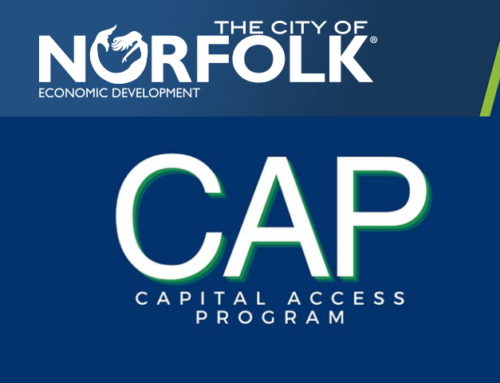Courtesy of the Hampton Roads Small Business Development Center
The SBA issued two sets of FAQs related to the new round of PPP funding. One focused on “first draw” borrowers while the document being addressed in this memorandum focuses on some of the unique aspects of the “second draw” program.
Calculating Revenue Reduction:
One of the most important qualifying requirements for Second Draw loans is that borrowers must show at least a 25% reduction “gross receipts” from 2019 and the same period in 2020. Based on this document, the agency defines gross receipts as:
1)For-profit business:
All revenue in whatever form received or accrued, from whatever source, including:
- Sales of products or services
- Interest
- Dividends
- Rents
- Royalties
- Fees
- Commissions
- Subcontractor costs
- Reimbursements for purchases made by a contractor at a customer’s request
- Investment income
- Payroll taxes
Reduced by returns and allowances but excluding net capital gains and losses.
Gross receipts do not include:
- Taxes collected for and remitted to a taxing authority if included in gross or total income
- Proceeds from transactions between a concern and its domestic or foreign affiliates, and
- Amounts collected for another by a travel agent, real estate agent, advertising agent, or other similar business types
2) Non-profit 501C(3), 501C(19) Veterans’ Organization, an eligible non-profit news organization, and eligible 501C(6) organization, or an eligible destination marketing organization
Gross receipts mean the gross amount received by the organization during its annual accounting period from all sources without reduction for any costs or expenses, including:
- Costs of good sold or assets sold
- Cost of operations
- Expenses of earning, raising, or collecting such amounts
- The amount received as contributions, gifts, grants, and similar amounts without reduction for the expenses of raising or collecting such amounts
- The amount received as dues or assessments from members or affiliated organizations without reduction for expenses attributable to the receipt of such amounts
- Gross sales or receipts from business activities, reported on form 990-T
- Investment Income, including:
- Interest
- Dividends
- Rents
- Royalties
- Gross receipts of affiliates are calculated by adding the receipts of the business and each affiliate
- Gross receipts exclude:
- PPP loan proceeds
- EIDL advances
The reference period term selected to reflect a 25% reduction in gross receipts to qualify for a Second Draw PPP depends on how long the applicant has been in operation, based on the following:
- For all applicants, except for those in certain situations, the applicant must show that gross receipts in any calendar quarter of 2020 were at least 25% lower than the same quarter in 2019.
- Applicants can also compare annual gross receipts in 2020 with annual gross receipts in 2019, if operational in 2019
- Entities that were not in business during the 1st or 2nd quarters of 2019 but were operational during the 3rd and 4th quarters of 2019, applicants must show that gross receipts in any quarter of 2020 were at least 25% lower than during either the 3rd or 4th quarter of 2019
- Entities that were not in business during the 1st, 2nd, or 3rd quarters of 2019 but were in operation during the 4thquarter of 2019 must show that gross receipts in any quarter of 2020 were at least 25% lower than the 4thquarter of 2019
- Entities that were not in operation during 2019 but were operational on 2/15/2020 must show that gross receipts during the 2nd, 3rd, or 4th quarter of 2020 were at least 25% lower than the 1st quarter of 2020
Required Documentation Includes (only 1 set of requirements are needed):
- Quarterly financial statements for the entity. If not audited, they must be signed as attested by borrower, and if the financial statements do not specifically reflect gross receipts, the applicant must annotate the lines that reflect gross receipts
- Quarterly or monthly bank statement from the borrower showing deposits from the relevant quarters. Borrowers are responsible for indicating which deposits represent gross receipts, and which do not
- Annual IRS income tax filings, and if 2020 tax returns have not been filed, applicant is responsible for completing a tax return, compute the relevant gross receipts value, sign, and date the tax return and attesting to the values are the same as those that will be filed in their official tax return
The amounts required to compute gross receipts varies by the tax return type, based on the following criteria:
- For self-employed individuals that file a 1040 Schedule C, the sum of lines 4 and 7
- For self-employed that file 1040 Schedule F, the sum of lines 1b and 9
- For form 1065 filers, the sum of lines 2 and 8, minus line 6
- For form 1120-S filers, the sum of lines 2 and 6, minus line 4
- For form 1120 filers, the sum of lines 2 and 11, minus the sum of lines 8 &
9or form 990 filers, the sum of lines 6b(i),6b(ii), 7b(i), 7b(ii), 8b, 9b, 10b, and 12 (column(A)) of part VIII
- For form 990-EZ filers, the sum of lines 5b, 6c, 7b, and 9 of part I
- LLCs should follow the instructions that apply to their tax filing status.
Note:
- Applicants seeking a Second Draw loan greater than $150,000 will be required to provide documentation substantiating the reduction in gross receipts deemed appropriate to support the amounts provided in the application.
- Applicants seeking a Second Draw loan $150,000 or less must provide documentation supporting the reduction in gross receipts at time of application or at the time they seek loan forgiveness. Subject documentation must show clearly identify the reference periods in question and support the amounts provided.
- Fiscal year tax filers can qualify if they can show the same reduction, as long as tax returns for the fiscal year contains all of the 2nd, 3rd, and 4th quarters of the calendar year.
Maximum Second Draw Loan Amounts:
Borrowers can use payroll costs from either calendar year 2019 or 2020. However, documentation, including IRS forms, must be supplied for the selected reference period. If the borrower is using the incumbent lender from their First Draw loan, then they do not need to provide the same information for their Second Draw application.
- Self-employed with no employees:
The maximum that can be borrowed is based on the following:
- Find 2019 net profit from form 1040 Schedule C, line 31
- If over $100,000, reduce to $100,000
- If -0- or less, the borrower is not eligible for a loan
Calculate average monthly net profit amount (divide by 12)
Multiply the average monthly net profit by 2.5 (or 3.5 for NAICS 72)
Required Documentation Includes:
- 2019 form 1040 Schedule C
- 2019 1099-MISC detailing non-employee compensation (box 7)
- 2019 form 1099-K
- 2019 invoices
- Bank statements or book of record indicating borrower was self-employed in 2019 and 2020, and same information showing borrower was operational on 2/15/2020
- Self-employed with employees:
The maximum amount is calculated based on the following:
- Compute 2019 payroll costs by adding the following:
- 2019 form 1040 Schedule C line 31 net profit (unless borrower is using 2020, and if so, they must fill out a pro forma 2020 tax return form)
- If the amount is over $100,000, then reduce it to $100,000
- If less than -0-, set the amount at -0-
- 2019 gross wages and tips paid to employees that are US residents, up to $100,000 each, using:
- 2019 form 941 – line 5C column 1 from each quarter
- Add pre-tax employee contributions for insurance or other fringe benefits
- Subtract amounts paid over $100,000 or are non-US residents
- 2019 employer contributions for employee insurance (1040 Schedule C, line 14)
- 2019 employer contributions to employee retirement plans (1040 Schedule C, line 19)
- 2019 employer state and local taxed assessed (from quarterly wage reporting forms)
Calculate average monthly payroll cost amounts (divide by 12)
Multiply average monthly payroll costs by 2.5 (or 3.5X for NAICS 72)
Required Documentation Includes:
- 2019 form 1040 Schedule C
- 2019 form 941 (quarterly)
- 2019 quarterly state unemployment insurance tax reporting form (or equivalent 3rd party form)
- Documentation supporting retirement or group insurance contributions
- Payroll or other statement reflecting operating status on 2/15/2020
- Self-employed farmer or rancher without employees:
These entities should use 1040 Schedule F instead of Schedule C. They use the same calculation as for Schedule C filers without employees.
- Self-employed farmer or rancher with employees:
For 1040 F filers with employees:
Instead of Schedule C, line 31, applicants should use the difference between Schedule F line 9 (gross income) and the sum of Schedule F, lines 15, 22, and 23 (employee payroll)
In addition, employer contributions for insurance (Schedule F, line 15) and retirement account contributions (Schedule F, line23) should be used
Required Documentation Includes:
- 2019 Form 1040, Schedule I and Schedule F
- For Schedule F filers with employees, include Form 943 instead of 941
- Partnerships:
Partners’ self-employment income should be included in the PPP application because individual partners cannot obtain their own loans. They should use the following calculations:
Compute 2019 payroll costs by adding the following:
- 2019 Schedule K-1 (form 1065), multiplied by .9235, up to $100,000 per partner
- Net earnings are subject to self-employment tax (box 14a, form 1065, Schedule K-1
Subtract:
- Any section 179 expense deductions
- Any unreimbursed partnership expenses claimed
- Any oil or gas depletion
- If this amount is over $100,000 per partner, reduce to $100,000
- If the amount is -0- or less, set at -0-
Add:
2019 gross wages and tips paid to US resident employees, capped at $100,000 per employee, computed using:
- 2019 Form 941 for each quarter
- Add any pre-tax employee contributions for insurance and other fringe benefits
Subtract:
- Any wages in excess of $100,000 per employee
- Any amounts paid to non-US resident employees
- 2019 employer contributions for employee (not partner) group insurance (form 1065 line 19)
- 2019 employer contributions for employee (but not partner) retirement plans (form 1065 line 18)
- 2019 state and local unemployment taxes
Calculate average monthly payroll costs (divide by 12)
Multiply average monthly payroll costs by 2.5 (or 3.5 if NAICS 72)
Required Documentation Includes:
- 2019 Form 1065 (including K-1)
- 2019 Form 941
- State quarterly wage unemployment insurance tax reporting for each quarter
- Documentation of all retirement and insurance payments made
- Proof that entity was in operation on 2/15/2020 and if employees claimed, then similar proof for the same date
- S and C Corporations:
Compute 2019 payroll costs by adding the following:
- 2019 gross wages and tips for US resident employees, capped at $100,000 per employee, using:
- 2019 Form 941 for each quarter
- Add pre-tax employee contributions for taxable income (line 5C, column 1)
Subtract
- Any amounts paid to employees in excess of $100,000
- Any amounts paid to non-US resident employees
Add
- 2019 employer contributions for insurance (Form 1120, line 24 or Form 1120-S line 18)
- 2019 employer retirement contributions (Form 1120 line 23 or Form 1120-S, line 17)
- 2019 quarterly wage reporting forms
Calculate average monthly payroll costs (divide by 12)
Multiply average monthly payroll costs by X 2.5 (3.5 for NAICS 72)
Required Documentation Includes:
- 2019 Form 941 for each quarter (or equivalent 3rd party records)
- 2019 filed 1120 or 1120-S
- Documentation supporting owner contributions for insurance and retirement accounts
- A payroll or similar record from the period including 2/15/2020
- Non-profit:
Compute payroll costs by adding the following:
- 2019 Form 941 for each quarter
- Add pre-tax employee contributions for health insurance excluded from Taxable Medicare wages and tips
Subtract:
- Any amounts paid to any individual employee over $100,000
- Any amounts paid to non-US resident employees
Add:
- 2019 employer insurance (Form 990, Part IX, line 9)
- 2019 employer retirement contributions (Form 990, Part IX, line 8)
- 2019 state unemployment taxes from quarterly filings
Calculate average monthly payroll costs (divide by 12)
Multiply average monthly payroll costs by 2.5 (3.5 for NAICS 72)
Required Documentation Includes:
- 2019 form 941
- Quarterly state unemployment insurance tax reporting
- 2019 filed form 990, part IX or 990-EZ
- Other documentation supporting retirement and group insurance payments
- Payroll or other records indicating employees on 2/15/2020
8) Nonprofit Religious institutions, veterans’ organizations, and tribal businesses:
Compute 2019 payroll costs by adding the following:
- 2019 gross wages and tips paid to US-resident employees, up to $100,000 per employee
- 2019 form 941 (line 5C, column 1) from each quarter
- Add pre-tax employee contributions for insurance or other fringe benefits excluded from Taxable Medicare wages
Subtract:
- Any amounts paid over $100,000 per employee
- Any non-US-resident employee
Add:
- 2019 employer group insurance contributions
- 2019 employer retirement contributions
- 2019 employer state and local taxes assessed (from quarterly reports)
Calculate average monthly payroll costs (divide by 12)
Multiply average monthly payroll costs by 2.5 (3.5 for NAICS 72)
Required Documentation Includes:
- 2019 form 941
- State quarterly wage unemployment tax reporting for each quarter (or equivalent 3rd party document)
- Documentation of employer contributions to retirement accounts, insurance, fringe benefits
- Proof that entity was operational 2/15/2020
- LLCs
Use the guidelines established for their tax filing status, i.e., partnership, sole proprietorship, or corporation
Required Documentation Includes:
- Form W-2, W-3, or payroll processing report reports
- Quarterly and annual tax reports in lieu of 941 reports
- Form 944 (very small businesses)
- Form 943 (if applicable)
- Documentation from retirement administrator to support employer contributions
- Documentation from insurance administrator to support employer contribution
10) Corporations or non-profits not in operation for the full year preceding 2/15/2020:
Compute total payroll costs from when first in operation in 2019 or 2020 thru the end of calendar year 2020 by adding the following:
- Gross wages and tips paid to employees that reside in the US, capped at $100,000, using the following:
- Form 941 taxable Medicare wages (line 5C, column 1) for each quarter
- Add pre-tax employer contributions for insurance and other fringe benefits excluded from Medicare wages
Subtract:
- Any amounts paid to non-US-resident employees
- Any amounts paid to individual employee in excess of the product of $8,333 and the number of months in operation through 2020
Add:
- Employer group health and other insurance
- Employer retirement contributions
- Employer state and local taxes from state quarterly wage reporting forms
Calculate average monthly payroll costs (divide by the number of months in operation from 2019 through the end of 2020
Multiply the average monthly payroll costs by 2.5 (3.5 for NAICS 72)
Required Documentation Includes:
- Form 941 and state/local quarterly wage unemployment insurance tax (or 3rd party equivalent records
- Documentation of any retirement and group insurance contributions
- Proof that entity was in operation with employees on 2/15/2020
- Self-employed or partnership in operation on 2/15/2020 but not in operation for a full year prior to that date:
The maximum Second Draw amount is the average monthly payroll based on the number of months in which the business was in operation from 2019 through the end of 2020, excluding costs over $100,000 on an annualized basis:
Compute total applicable owner compensation in 2019 and 2020, based on tax returns:
Self-employed Schedule C filers
- Sum of the value of Form 1040 Schedule C, line 31 (net profit)
- If less than -0-, set the amount as -0-
Self-employed farmer or rancher with no employees
- Sum of the value of Form 1040 Schedule F, line 9 (gross income)
Self-employed farmer or rancher with employees
- Sum of the difference between the gross income amount on Form 1040 Schedule F, line 9, and employee and payroll costs from Form 1040 Schedule F, lines 15, 22, and 23
- If less than -0-, set the amount as -0-
Partnerships
- Sum of Schedule K-1 (Form 1065) net earnings from self-employment of US based general partners, multiplied by .9235
Compute net earnings from Form 1065, Box 14a
Subtract
- Any section 179 expense
- Any unreimbursed partnership expenses
- Any oil or gas depletion expenses claimed
If the amount is greater than the product of $8,3333 and the number of months in operation 2019 and 2020. This cap applies separately to each general partner
If the entity has employees, enter the amount computed from FAQ #10 or enter -0-
Calculate the average monthly payroll costs by adding steps above divided by the number of months in operation from 2019 and 2020
Multiply the average monthly payroll costs from above by 2.5 (3.5 for NAICS 72)
Required Documentation Includes:
- Applicable tax return (1040 C, F, or 1065 (including K-1)) from 2019 (if applicable) and 2020
- If entity has employees, provide 941 and state quarterly unemployment payments (or equivalent)
- Documentation of retirement accounts and insurance expenses
- Payroll statement or similar documentation from the pay period that included 2/15/2020
- If no employees, bank statement or similar documents proving operating status on 2/15/2020
Miscellaneous FAQs
12) Requirement for payroll costs are different than when First Draw was obtained:
Payroll costs from the precise 12-month period prior to the first draw cannot be used to compute the Second Draw loan amount. Second Draw requests can use either 2019 or 2020 payroll costs, which may be advantageous for some borrowers.
13) If the NAICS 72 is missing from the applicant’s tax return, they must be able to prove alternative documentation, such as permits or licenses issued that are unique to the sector.
14) In addition to pre-tax employee contributions for health insurance, other categories of expenses include FSA deductions, other section 125 cafeteria plan expenses, group life insurance, or other expenses not included in Medicare taxable income.






